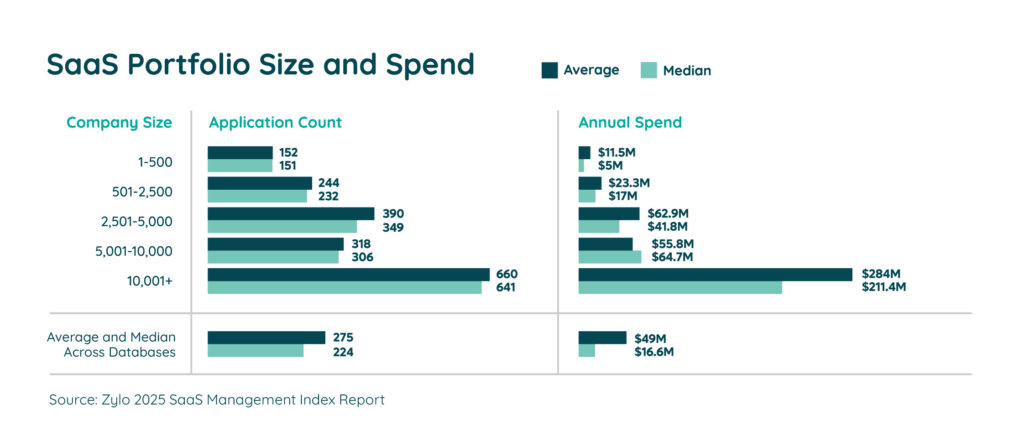Table of Contents
Planning proves critical to all facets of business success. Growing organizations today experience a flurry of operational changes, not to mention they must manage a revolving door of SaaS applications entering and exiting the business on a monthly clip.
An IT roadmap outlines a business’s immediate and long-term goals surrounding core technology initiatives, infrastructure needs, and software acquisition. It helps businesses align to strategic goals and prioritize resources, save money by eliminating inefficiencies and redirecting budgets to high-value actions, and ensure technology systems run optimally while reducing risk.
Unlike product roadmaps that are geared toward customers and the market at large, IT roadmaps serve an internal audience. Read on to learn about the challenges a roadmap addresses, processes to design a roadmap, and tools to successfully execute the strategy.
Consider the IT Roadmap Process
As you think about designing your process, it’s important to note that an IT roadmap looks different depending on the business and its unique vision. Put simply: It’s not a one-size-fits-all approach. The key is to consider your strategic needs and plan accordingly. The IT roadmap process typically includes the following three components:
- IT works with key business units to understand processes, pain points, and current technologies and tools, then plots the findings on a capabilities map.
- IT then identifies opportunities for improvement, including low-hanging fruit and long-term projects, based on pain points and discussions with business leaders.
- C-level executives provide direction and input on priorities – this is your north star.
Use Benchmark Data to Inform IT Roadmap Decisions
As with proving the business case for any major initiative, take advantage of available benchmarking data to validate and inform key IT decisions.
Benchmarking involves evaluating and comparing data against internal or external sources to optimize processes, reduce spend, and improve performance. A SaaS Management Platform shows the number of licenses you hold for each application, as well as utilization and cost data. Benchmarking looks even deeper, allowing you to see how your organization compares to businesses of similar size and industry.

For example, let’s say HR wants to push through new employee portal software. You could examine their departmental spending to see how their spend compares to other cost centers. Are they already spending more than their peers? Does the software align to strategic business priorities? If not, then it may not be a high priority for the IT roadmap.
Ultimately, you want to highlight popular app benchmarks to show what organizations like you use to solve the same problems, and then leverage price benchmarks to ensure your organization pays a comparable price.
Get Creative with Problem Solving
During uncertain economic times, organizations need to get creative and think outside the box to solve inefficiencies and reduce costs. You can often solve problems with process improvement, rather than investing in new technologies or tools.
For instance, look at your SaaS data to find redundant apps and consolidate when possible. Zylo data shows the average large company pays for an average of 660 applications, often with several performing overlapping functions.

Hold conversations with each business unit and ask, “Are you truly using all these tools?” It’s not always easy to convince leaders to switch or remove apps, so use data to drive the conversation. And even if you can’t remove an app in the near-term, put it on a list for eventual phase-out.
If you’re looking to fund new projects, take advantage of low-hanging fruit by examining your current portfolio for opportunities to optimize and free up funds you assumed were already allocated.
Deploy the Right IT Resources
An effective IT roadmap and successful SaaS Management strategy requires the right mix of personnel and technology.
Ask yourself: “Do we have the right people in place to manage these tools, such as an IT Asset Manager or dedicated SaaS Manager?” If not, what does your organization plan to do about it? Because the more applications you add, the more people it takes to manage them. In fact, Zylo data shows the average organization adds six new tools every 30 days.
Even with the right team members in place, do you have the right technology to serve as a single source of truth, such as a SaaS Management Platform? A comprehensive SaaS governance platform provides full visibility of your entire SaaS portfolio — including apps expensed by employees — to ensure alignment across the business.
Zylo’s top-rated SaaS Management Platform provides organizations with:
- Full SaaS discovery
- Key integrations with popular tools
- Actionable insights to optimize your portfolio and reduce costs
- Real-time SaaS benchmarks
At Zylo, we have the tools, support, and years of insightful customer data to help you think through and execute your IT roadmap and larger SaaS Management strategy. Ready to learn more? Request a demo.


